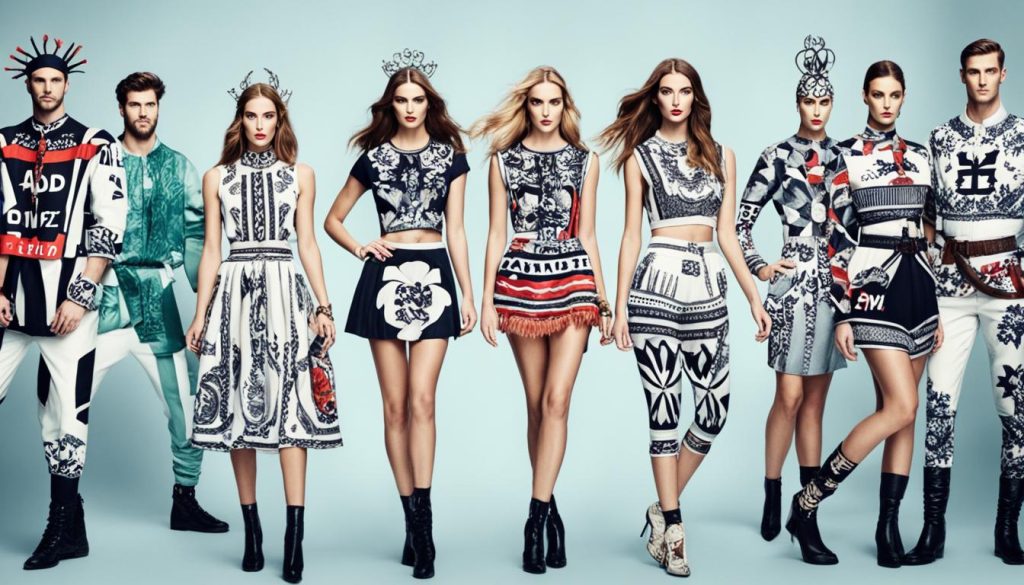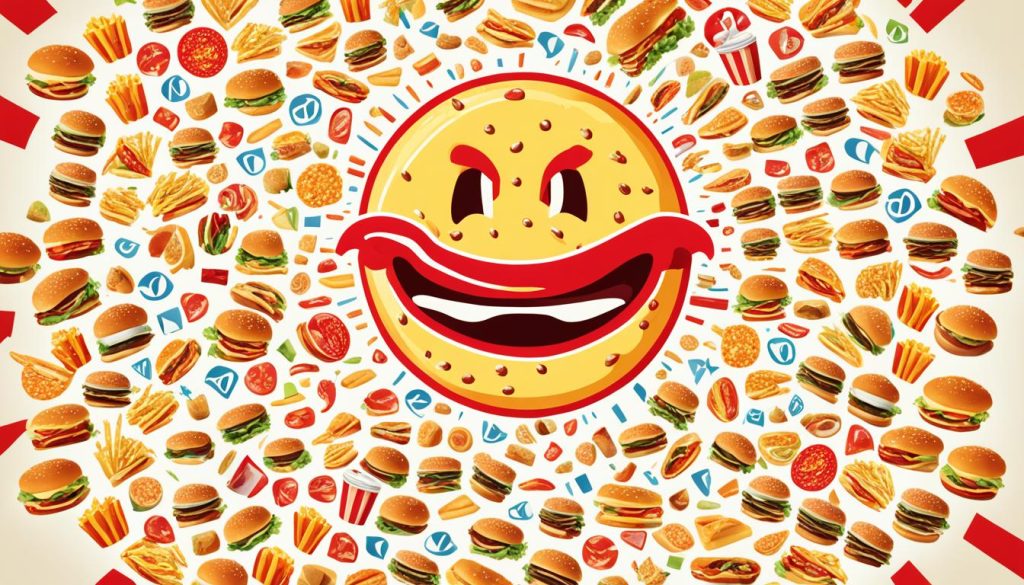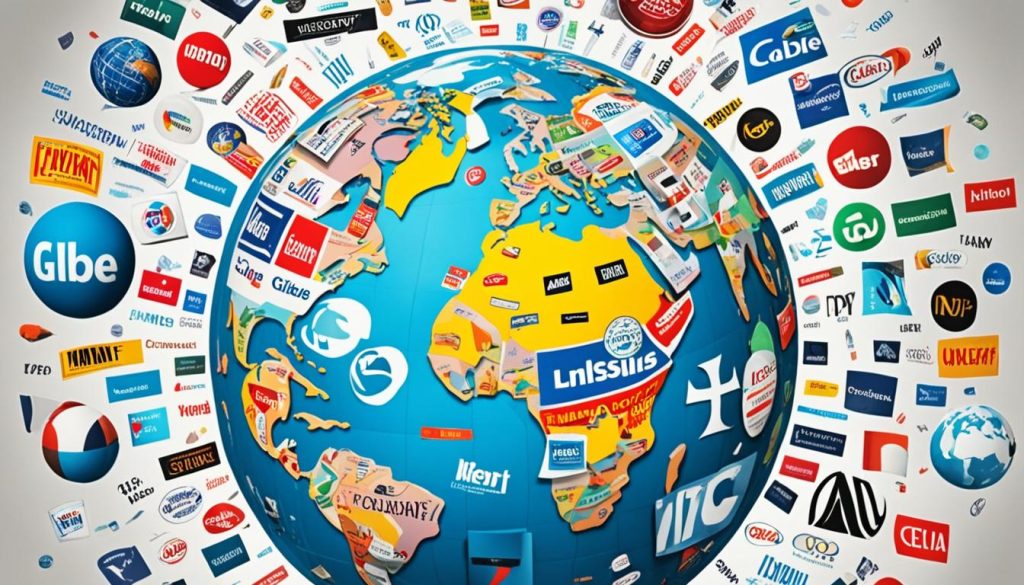In the world of global marketing, even top brands can mess up. These examples show why businesses aiming for worldwide success must be careful. From clothes with offensive phrases to ads that ignored local culture, companies have seen their share of global blunders. These mistakes highlight how crucial research and understanding different cultures are in marketing strategies.
Key Takeaways
- Doing your homework on the market is key to successful branding.
- Being culturally sensitive is vital in avoiding international marketing mistakes.
- Ad translations gone wrong can cause big problems worldwide.
- Brands can learn from past errors to better face global market challenges.
- It’s important for brands to keep an eye on their strategies to stay liked worldwide.
Introduction to Global Branding Missteps
Globalisation has changed how companies approach branding. They can now easily tap into new markets. Yet, this comes with challenges, such as avoiding global market pitfalls.
One big mistake brands make is not paying attention to cultural differences. Overlooking local customs and consumer habits can cause major branding fails. For example, an advert might work in one country but offend people in another. This shows the importance of understanding cultural sensitivities for global success.
Language mistakes are another key issue in global branding. Many errors come from wrong translations. These can turn intended messages into laughable or offensive content. Accurate translations that consider cultural nuances can help avoid these blunders.
Using the same strategy everywhere often leads to trouble too. It’s better to customise campaigns for each place. This shows respect for each culture and helps win the loyalty of various consumers. Doing proper research and getting local insights are vital. They help brands avoid common errors and succeed on a global scale.
Why Do Branding Failures Happen?
Branding failures often come from many issues like poor market understanding or lacking cultural sensitivity. If companies want to grow globally, they must avoid these traps to succeed in different markets.
Lack of Market Research
Not doing enough market research can harm a brand greatly. If companies don’t grasp what local consumers like, they can push them away. Good market research ensures products and adverts appeal to the target audience, reducing cultural misunderstandings.
Cultural Sensitivity Issues
Cultural issues are a key reason for branding mistakes. A successful campaign in one place might upset people elsewhere because of cultural differences. Hiring cultural consultants or having a diverse team ensures messages fit well with local cultures.
Translation Blunders
Errors in translating can embarrass a brand and cost a lot. Problems come when direct translations mess up the intended meaning. Using native speakers for localisation can keep the original message clear and prevent harmful brand images.
The H&M Controversy

The H&M controversy is a lesson on what happens when advertising doesn’t consider culture. In 2018, H&M got a lot of negative attention. They showed a young black boy in a hoodie with “Coolest Monkey in the Jungle” printed on it. This caused a lot of people to become very upset, leading to calls for boycotting the brand.
It showed how important it is to understand culture in branding. After the ad went out, many people on platforms like Twitter and Instagram criticized H&M. They accused the brand of not being aware of cultural sensitivities. H&M responded by saying sorry and taking the hoodie off their shelves.
This whole situation teaches that brands need to think carefully about cultural issues. To manage such problems well, brands must do more than just fix the immediate mistake. They need to work on being more inclusive and sensitive to different cultures over the long term.
Estee Lauder’s Limited Shades
Estee Lauder, a big name in beauty, faced trouble over its narrow range of shades for dark skin. This sparked a lot of critique and questions about whether they include everyone.
This issue didn’t just point out problems in the beauty world. It also led to claims of leaving some people out. Many customers were upset, highlighting the big gap in options for different skin tones.
The backlash did harm to Estee Lauder’s brand reputation. It reminded companies of the importance of including all skin tones in their lines. Products in the future need to represent more people to avoid harm and welcome everyone.
Heinz QR Code Disaster
The Heinz QR code debacle is a key lesson in the pitfalls of brand management. A consumer scanned a QR code on their ketchup, hoping for special offers from Heinz. Instead, they landed on a site they didn’t expect, showcasing the dangers of overlooked digital spaces.
It shows why it’s vital to check and recheck our marketing tools. Making sure QR codes take people where they’re supposed to go is essential. It helps keep our brand’s image clean and our customers happy. With more folks clicking on digital ads, the importance of this vigilance is bigger than ever.
This mistake is a glaring reminder of the impact small oversights can have. For a big name like Heinz, such mishaps not only hurt their good name. They also point out the danger lurking in modern-day advertising. To use QR codes well, we need careful planning and constant check-ups. This ensures users get the experience they’re promised.
Cadbury and the Easter Egg Hunt Uproar

Cadbury caused a storm with a change to its egg hunt. They took out ‘Easter’ from the event’s promotions. This move aimed to include more people but sparked a big uproar instead.
People saw this as ignoring Easter’s cultural and religious meaning. There was a lot of criticism from the public and politicians. Changing the tradition was viewed as a mistake, making many feel left out.
Cadbury tried to reach a wider audience but faced backlash. They seemed to overlook the importance of Easter traditions. To calm the storm, they worked to rebuild trust and show their cultural respect.
Paddy Power’s Immigrant Ad
Paddy Power is known for pushing boundaries in advertising. But, they crossed a line with a recent campaign. It used the immigrant crisis to grab attention, which many found insensitive and in poor taste. This move was seen as a big mistake, offending the public and showing a lack of empathy.
Brands need to think about how their ads affect society and culture. The backlash against Paddy Power’s ad shows what happens when they don’t. Controversy can catch people’s eyes, but here, it damaged the brand’s image severely. It’s a lesson in the value of being sensitive and thinking carefully before acting.
Coca-Cola’s Map Mix-Up
Getting geography right in advertisements is key, as Coca-Cola found out during a backlash in Russia. They accidentally left Crimea off a map of Russia, causing a big upset. This mistake led to many Russian customers expressing their anger on social media.
Such advertising mistakes can really harm a brand’s image. They show a brand doesn’t respect local feelings or national pride. Errors like this can cause boycotts and even ongoing anger at the brand. To avoid these issues, global brands must check their ads for accuracy and sensitivity.
Nowadays, a small mistake can quickly turn into a big problem due to social media. Especially with issues about politics or land, even a little slip-up can cause trouble worldwide. This shows how important it is for international marketing to understand geography and culture very carefully.
McDonald’s Mayo Misfire

When McDonald’s tried to add a sophisticated mayo option to their menu, things didn’t go as planned. The goal was to attract different customers with a new brand strategy. But it turned out to show a big brand strategy misalignment with audience preference.
The product launch failure was because they didn’t truly understand what their usual customers wanted. There wasn’t enough research done, showing how vital market analysis importance is. People used to McDonald’s usual menu didn’t like the new mayo. They weren’t interested, leading to its poor welcome. This teaches us the importance of knowing what your customers like.
The market analysis importance really cannot be ignored. Without deep research and understanding what people want, brands can push their main customers away. McDonald’s learned this the hard way with their mayo attempt. It was an expensive mistake that showed the need to really understand the market.
Target’s Offensive Father’s Day Card
Target recently faced criticism over an insensitive Father’s Day card. It had racially charged images that upset many people. This led to a lot of people calling it offensive and inappropriate.
The card was supposed to be funny but instead caused anger. People took to social media to express their disappointment. They criticized Target for not being culturally sensitive.
Target quickly reacted to the public’s response by removing the cards. They apologised and promised to watch their products more closely. This was to fix their public image and regain trust.
This issue shows the need for being careful and sensitive in marketing. Companies must learn from such mistakes. They need to ensure they don’t make similar errors with products that might offend.
- Identify potential cultural sensitivity issues before launching new products.
- Listen to and engage with customer feedback to address concerns promptly.
- Implement comprehensive review processes to prevent insensitive greeting card messages and other similar issues.
Domino’s Tattoo Promotion
Domino’s Pizza launched a bold campaign, offering free pizza for life for tattooing their logo. This initiative quickly went awry, leading to an unexpected surge in participation. The company had to act fast.
The Overwhelming Response
Domino’s attempt to increase customer interest backfired massively. They didn’t expect thousands to show off their tattoos on social media, hoping to win free pizza. This left Domino’s struggling to manage the outcome financially and logistically.
How Domino’s Managed the Fallout
With too many people joining, Domino’s had to change the promotion’s terms quickly, deciding on a winner limit. This move was their way of fixing the mishap. It shows why it’s vital to plan promotions well, considering their possible scale.
The Milwaukee Bucks’ Twitter Celebration

The Milwaukee Bucks’ tweet meant to celebrate turned into a big mistake. It was meant to show joy but ended up being a lesson on what not to do on social media. This was at a time when the team was changing a lot internally, and the tweet’s timing couldn’t have been worse.
This event shows that missteps in online marketing can spark backlash. The Bucks aimed for a positive reaction but instead found themselves under a microscope. This reflects the wider issue of managing public relations well. Being careful with social media, especially during big changes, is vital.
- Social media communication errors can rapidly escalate into broader PR issues.
- Misjudged online those marketing, especially during transitional periods, may backfire.
- Team public relation challenges are amplified by real-time social media reactions.
Understanding these points is important for sports teams and businesses in managing their online image.
Dolce & Gabbana’s Culturally Insensitive Ad
Dolce & Gabbana, a famous luxury fashion brand, faced lots of criticism for their ad. The ad showed a Chinese model trying to eat Italian food with chopsticks. It was seen as using stereotypes harmfully. This ad quickly spread online for the wrong reasons, causing a lot of anger on social media.
Many people, especially in China, felt mocked by the ad and started boycotting the brand. This led to a big drop in support for Dolce & Gabbana. Big names and shoppers all started avoiding their products. Even major online shops in China stopped selling their items, showing how upset people were.
This issue really hurt Dolce & Gabbana’s image and sales, especially in China. They even had to cancel a big fashion show in Shanghai because of the uproar. It showed how important it is for brands to understand cultures in their marketing. To avoid losing their audience and damaging their reputation, brands must be careful and respectful.
Pringles Fat-Free Chips Fiasco
The launch of Pringles’ fat-free chips was meant to shake things up. Sadly, these chips became known for all the wrong reasons. Misleading health claims and unhappy customers mainly caused the trouble.
Consumer Expectations vs Reality
Pringles said their fat-free chips were a healthier snack choice. People liked the idea of guilt-free chips. But the reality didn’t live up to their hopes, leading to lots of complaints.
The Ingredient Controversy
Olestra, an artificial fat substitute, was a key issue. It made the chips fat-free but caused stomach problems for many. This situation showed how vital clear and honest advertising is. The story of Pringles’ fat-free chips teaches us the importance of balancing innovation with consumer well-being and honesty.
Understanding and Avoiding Global Branding Fails
Starting a brand globally is like walking on a thin line. One side has huge chances for growth, and the other has risks. To avoid mistakes, companies must carefully analyze their marketing strategies. It’s crucial to know about the different cultures, languages, and feelings in various areas. A small error, such as not respecting a culture or wrong translations, can hurt a brand’s reputation and turn people away.
Communicating well across the globe is key and needs empathy. Brands should do detailed market research with help from locals. These locals know the cultural subtleties and what people like in their area. This helps to create messages that people will like and not get upset or confused by.
The key to great branding is detailed planning and knowing international markets well. Communications must be planned carefully to be respectful and relevant. This way, businesses can grow globally, gaining trust and loyalty from many. Being careful and understanding can change possible mistakes into chances for real connections and growth.
Source Links
- https://fullstop360.medium.com/20-epic-branding-mistakes-that-you-should-not-miss-out-on-4e5ba6a7efe0
- https://www.linkedin.com/posts/jabboallen_20-epic-fails-in-global-branding-activity-6976604345165303808-M1g8?trk=public_profile_share_view
- https://www.businessnewsdaily.com/5241-international-marketing-fails.html
















